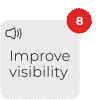Five Key Questions
to Guide Your AP Automation Strategy

If you’re evaluating AP automation, asking the right questions upfront can save your team time, money, and frustration. Your finance team processes 200+ invoices monthly using a combination of email approvals, Excel tracking, and manual data entry.
If this sounds familiar, you’re losing more money than you realize—and it’s not just in software costs. But what’s holding your team back might not be obvious at first glance. These five questions will help you identify the biggest inefficiencies in your current process and prioritize which automation features will deliver the highest ROI.
What is the real cost of our current AP process and are we measuring it?
You probably know what you’re spending on software and staffing. But what about the hidden costs? Think late fees, missed early payment discounts, or the hours your team spends chasing down approvals. Manual AP drains time and money in ways that often go unnoticed until the impact starts to snowball.
What to consider:
Track total processing time from invoice receipt to payment (industry benchmark: 5-7 days)
Calculate missed early payment discounts over the last 6 months
Measure hours spent weekly on invoice exceptions and approvals
Are we still building workflows around our limitations?
Your current process probably includes workarounds you don’t even notice anymore. Finance teams often create workarounds to get by with outdated systems. Routing approvals through email, uploading the same document into multiple places, or retyping data across tools might get the job done, but it’s inefficient and risky.
Look for signs of workaround culture:
Are steps duplicated across departments?
Are processes different depending on who’s handling them?
Is tribal knowledge doing more of the heavy lifting than your systems?
STEVEN BODINE, CUMBERLAND INTERNATIONAL TRUCKS
Can our current tech stack scale with us or is it holding us back?
Growth doesn’t just bring more invoices. It adds layers of complexity with more vendors, more stakeholders, and higher expectations around speed and accuracy. Manual systems that once worked fine can quickly become major blockers when the volume picks up.
Ask yourself:
Are we set up to handle 25% more invoice volume with our current resources?
Would we need to grow the team, or can smarter tools do the heavy lifting?
How easy is it to onboard new vendors or business units?
Are we making decisions with accurate data?
When information lives across spreadsheets, inboxes, and siloed systems, visibility suffers. That affects everything from cash flow forecasting to month-end close. Decisions made with outdated or incomplete data can slow down more than just finance.
Automation helps you:
Gain real-time visibility into spend and cash flow
Reconcile faster and more accurately
Establish one reliable source of truth across your systems
Is your team spending time on strategic analysis or administrative tasks?
Hiring is tough. Burnout is real. And nobody wants to spend their day chasing down invoice approvals or copying and pasting data from one screen to another. The right automation doesn’t replace your team. It gives them the tools to be more strategic and less reactive.
What to aim for:
Fewer repetitive tasks
Less time spent on manual matching
More engaged teams set up to do higher-value work



The Bottom Line
If you’re unsure about any of these questions, it’s a sign your current process might not be keeping up. The good news? You don’t have to fix everything at once. onPhase helps finance teams modernize AP with automation that’s built to scale, easy to use, and ready to work from day one.
Dive Deeper, Move Faster
If you’re rethinking your AP workflow for the second half of the year, these quick reads are a great next step.




.png)